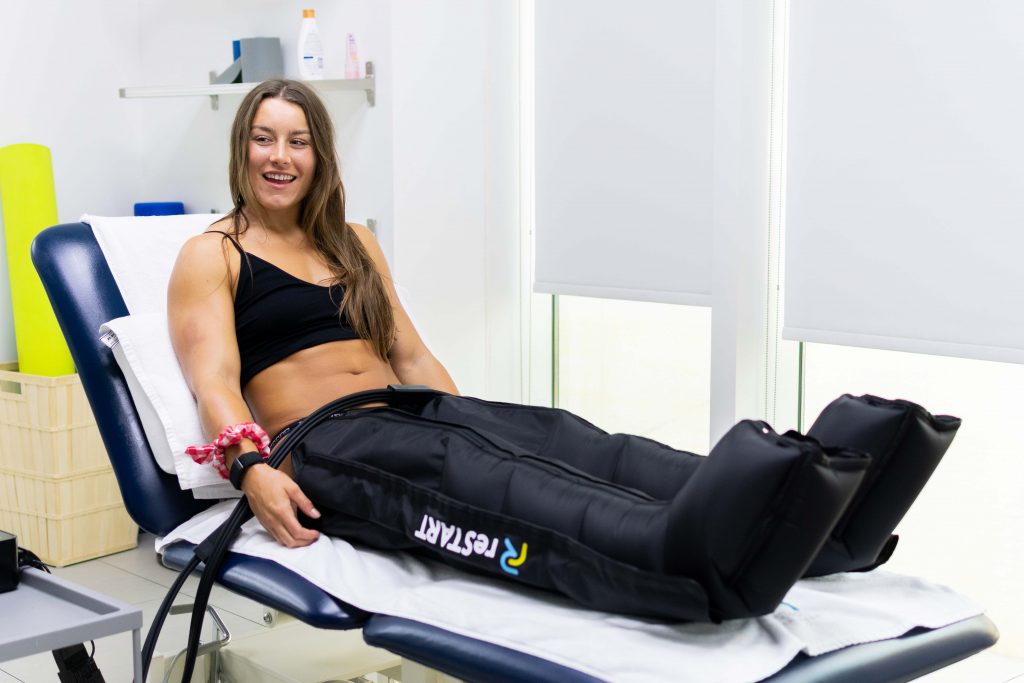Introduction:
Compression therapy is a recovery system that consists of inflatable compression sleeves worn on the extremities; most often, it is a boot that encloses the foot to upper thigh.
The compression sleeves consist of a series of compartments in the boot. The compression boots have different settings. Depending on an athlete’s preference, will determine what setting will be best. For example, the compartments inflate sequentially from distal to proximal in one setting and remain pressurized until all the compartments, or zones, are inflated. This is a description of only one setting. (Verma, Sharma & Hussain, 2017).
The NormaTec Pulse 2.0 Leg Recovery System is comprised of individual sleeves designed to cover your legs. Each sleeve has five separate zones located from your feet up to your hips. It works by pulsing and holding air in each zone throughout a timed sequence. This promotes enhanced blood flow while helping reduce soreness and speed up recovery.
The new reSTART version has 6 compartments and 4 different settings to choose from.
The system is intended to imitate the body’s normal physiological processes (“biomimicry”), which increases venous return by applying pulsing compression, distal release, and gradients. The compression therapy recovery system accelerates the body’s ability to passively clear metabolites, faster than passive recovery (Zierau, 2019).
How does compression therapy work?
Many leading athletes, trainers and fitness enthusiast around the world currently use this technology (Studd, 2009).
These enthusiasts include:
Lebron James (professional basketball player)
Emily Seebohm (Australian swimmer)
Mick Fanning (3-time surfing world champion)
Richard Thompson, (2018 ultra-man world champion)
David Warner (Australian professional cricketer)
This innovative technology uses air pressure, patented massage patterns that works on different parts of the body. This air pressure massage aids in relieving muscle aches and/or pain temporarily by improving circulation to the treated areas.
It effectively mimics the natural motions of the arms and legs to remove metabolites and fluids from the limbs after intense activity. The pulsing movements are helpful for preventing injuries and accelerating recovery time (Marcello, R. T., et al., 2019).
Instead of using static compression (squeezing) to transport fluid out of the limbs, Compression therapy is a Pulse Technology that uses dynamic compression (pulsing). The pulsing action is more effective and imitates the muscle pump action of the legs and arms, and greatly enhancing the movement of fluid and metabolites out of the limbs after an intense workout (Kevin Stetter, E. H. 2013).
Veins and lymphatic vessels have one-way valves that prevent fluid to flow back. Similarly, compression Pulse Technology uses pressure to prevent fluids from being forced in the wrong direction (Hoffman, M. D., et al., 2016).
This dynamic compression device uses compressed air to massage limbs, mobilize fluid, and fight inflammation. Limbs are inserted into sleeves that are inflated to compress the muscles. The compression system then pulses up the limbs, squeezing pain-causing fluid & lactic acid out of them. The limbs are then replenished with fresh blood, stimulating recovery (Bishop, P. A., et al., 2008).
What are the benefits of compression therapy?
- Increases ROM
The peristaltic pump (hold and release) pulse dynamic compression rapidly enhances acute range of motion with less discomfort and time (Crowther, F., et al., 2017).
- Lessen pain sensitivity
Peristaltic pulse dynamic compression is a promising means of accelerating and enhancing recovery by reducing muscle tenderness with pressure stimuli (Weerapong, P., et al., 2005).
- Treatment for DOMS
A 30-minute treatment of pulse compression increases blood flow in the lower extremity. Thus, making pulse compression a viable option in the management of DOMS and faster recovery (Weerapong, P., et al., 2005).
- Clears metabolites passively
It significantly lowers blood lactate concentrations when compared to a passive recovery group (Weerapong, P., et al., 2005).
References:
- Bishop, P. A., Jones, E., & Woods, A. K. (2008). Recovery From Training: A Brief Review: Brief Review. Journal of Strength and Conditioning Research, 22(3), 1015–1024.
- Crowther, F., Sealey, R., Crowe, M., Edwards, A., & Halson, S. (2017). Influence of recovery strategies upon performance and perceptions following fatiguing exercise: A randomized controlled trial. BMC Sports Science, Medicine and Rehabilitation, 9(1), 25. https://doi.org/10.1186/s13102-017-0087-8
- Hoffman, M. D., Badowski, N., Chin, J., & Stuempfle, K. J. (2016). A Randomized Controlled Trial of Massage and Pneumatic Compression for Ultramarathon Recovery. Journal of Orthopaedic & Sports Physical Therapy, 46(5), 320–326. https://doi.org/10.2519/jospt.2016.6455
- Kevin Stetter, E. H. (2013). An Intermittent Pneumatic Compression Device Reduces Blood Lactate Concentrations More Effectively Than Passive Recovery after Wingate Testing. Journal of Athletic Enhancement, 02(03). https://doi.org/10.4172/2324-9080.1000115
- Marcello, R. T., Fortini, L., & Greer, B. K. (2019). Intermittent Pneumatic Compression Boot Use Elevates Blood Lactate During Subsequent Exercise. 9.
- Studd, C. (2009). Compression therapy. Nursing Standard, 23(30), 59-60. doi: 10.7748/ns.23.30.59.s53
- Verma, S., Sharma, L., & Hussain, M. (2017). Effect of recovery modalities on blood lactate clearance. Saudi Journal Of Sports Medicine, 17(2), 65. doi: 10.4103/1319-6308.207577
- Weerapong, P., Hume, P. A., & Kolt, G. S. (2005). The Mechanisms of Massage and Effects on Performance, Muscle Recovery and Injury Prevention: Sports Medicine, 35(3), 235–256. https://doi.org/10.2165/00007256-200535030-00004
- Zierau, U. (2019). Intermittent Compression Massage Therapy After Varicose Vein Therapy. Surgical Research, 1(1). doi: 10.33425/2689-1093.1003
Copyright © 2021 reSTART. All rights reserved.
